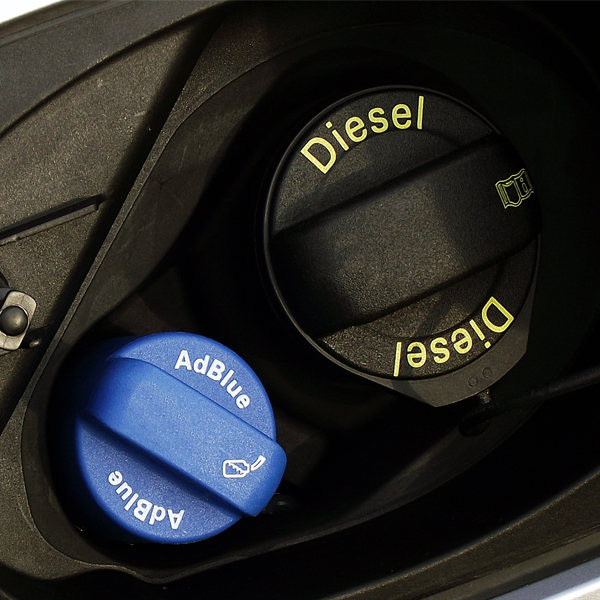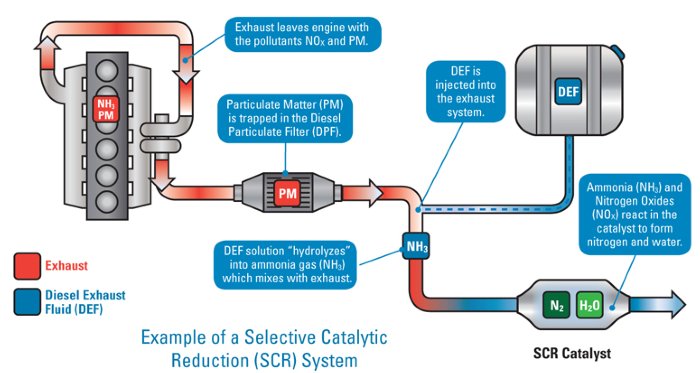
As an experienced petrol technician, you may have heard diesel techs discuss selective catalytic reduction as a means to control diesel exhaust emissions, and you may have wondered what they were talking about. If this is the case, you are not alone; In fact, many diesel techs do not fully understand the technology, so in this overview we will briefly discuss what selective catalytic reduction is, what applications use it, why it is used, how it works, as well as some common issues and troubleshooting tips, starting with this question-
What is selective catalytic reduction?
While selective catalytic reduction as a means to control diesel emissions has been in widespread use in construction, the power generation industry and even maritime applications since the late 1950’s, its use in automotive applications was limited until 2010, when some markets mandated its use in heavy road transport equipment. In recent years, more and more manufacturers have opted to use the technology to satisfy the increasingly stringent emissions requirements applicable to light vehicles.
In simple terms, the technology revolves around a continuous chemical process in which a liquid reductant (urea obtained from ammonia) is injected into the exhaust stream to selectively target the various oxides of nitrogen present in diesel exhaust, and then to convert these substances (commonly known as NOx), into mainly nitrogen and water.
NOTE: This process should not be confused with the process that removes the solid particular matter (soot) from diesel exhaust, which depends on entirely different components, methods, and control systems.
Why use selective catalytic reduction technology?
While engine design and electronic control of the combustion process on diesel engines have gone a long way towards complying with emission control regulation/standards, the nature of diesel exhaust is such that a new approach was required. Although emission control on diesel engines has reached high efficiency levels in recent years, existing technologies are no longer able to satisfy the requirements of ever more stringent emissions regulations in most jurisdictions.
While NOx forms only about 12% or so of the total volume of diesel emissions, and ranks only third on the list of the most harmful greenhouse gases after carbon dioxide and methane, it must be borne in mind that NOx has the ability trap more than 300 times as much heat as carbon dioxide. This sobering fact puts the need to control the formation in and emission of NOx from, diesel engines in another light entirely.
Therefore, instead of reinventing the wheel, so to speak, car manufacturers elected to use selective catalytic reduction, since it was known to be effective, and could be relatively easily adapted for use in automotive applications. Moreover, the main advantage that selective catalytic reduction has over other methods of controlling NOx levels, such as EGR (Exhaust Gas Recirculation) is that unlike EGR, which affects combustion, selective catalytic reduction takes place after the combustion process has completed. In practice, this means that neither engine performance, nor fuel economy suffers during the reduction process.
How does selective catalytic reduction work?

Image credit: tersusdef.com
The simplified schematic diagram shown above represents a typical selective catalytic reduction system on a typical light vehicle. Note that although only the principal components of the system are shown here, it should serve to illustrate the basic operating principles of the system.
NOTE: Not shown here are the reductant injector and pump, and their associated plumbing, the dosing unit, the sensors that monitor the efficiency of the system, as well as these components’ control/signal/ monitoring circuits, which, while they follow the same general pattern, are nevertheless somewhat different between applications.
Nonetheless, on a fully functional system, the amount of reductant that is injected into the exhaust stream varies, with the variations based on current operating conditions such as varying engine speeds/loads. In all cases though, the amount of injected reductant is electronically controlled in an extremely narrow range on either side of the required volume for two reasons-
It must be noted though that the injection of reductant is automatic, if not autonomous, and requires no inputs or interventions from the driver. Typically, though, conversion of NOx is most efficient at certain temperatures, but how efficient the process is depends both on which catalyst is used, and on whether or not the conversion environment is at the optimum temperature for any given catalytic material, which is typically base metals like titanium oxide, vanadium, tungsten, molybdenum, and various aluminosilicate minerals.
Typically, conversion is most efficient in a range of temperatures from about 3600C, to about 4500C. Provided all conditions are met, efficiencies in removing NOx can be as high as 90% or more, while efficiencies of between 50% and 90% can be achieved in removing hydrocarbons in the form of particulate matter (soot) and carbon monoxide if the DPF and its associated systems are in good working order.
In practice, and on a typical, fully functional system, the PCM compares input data from the engine speed sensor, throttle pedal position sensor, engine coolant sensor, and other devices such as data from one or more NOx, and/or exhaust gas temperature sensors (and sometimes exhaust gas pressure sensors) to calculate the overall efficiency of the NOx conversion process.
Based on this calculation and its results, the PCM calculates the required amount of reductant to inject into the exhaust stream either to correct/adjust the process, or to maintain the current NOx content in the exhaust. This data is then communicated to the reductant dosing unit, which then manages the actual injection of the reductant via a dedicated injection pump and its associated pressure/flow monitoring equipment.
So, what can go wrong?
As it turns out, many things can go wrong, since the typical selective catalytic reduction system tends to be rather complicated, and it requires precise control and monitoring which in turn, depend on accurate input data from a variety of sensors and devices, all of which have to be in perfect working order. Failure of one sensor and/or its control circuit can cause issues ranging from loss of power, to excessive smoking, to the vehicle being locked into a limp mode, with the actual issue depending on the nature of the failure.
However, the most common issues involve the reductant itself. Known the world over as AdBlue, the reductant consists of a mixture of 32.5% urea, and 67.5% de-ionised water. In this ratio, the water and urea fractions freeze and thaw at the same temperature, and while freezing of the mixture is not a real problem in Australia, the availability, and purity of the fluid may be, since the efficient conversion of NOx depends on there being no dissolved metals or salts present in the mixture.
Typical AdBlue reductant usage ranges from about 1% to about 4% of fuel usage, and while all vehicles with selective catalytic reduction systems have dedicated level gauges to indicate the available amount of reductant, running out will force the vehicle into a limp mode that will persist until the reductant supply is replenished to above a minimum level. Note that since the holding capacity of reductant tanks vary between applications, some applications may only be able to cover about 3000 km on a full reductant tank, while others may be able to cover as much as 30 000 km between fills.
However, since the efficiency of the process of converting NOx on diesel applications depends on the temperature of the conversion environment, any problem, issue, malfunction, or defect that affects that temperature or the PCM’s ability to monitor that temperature effectively will almost invariably set off one or more trouble codes, of which the following is a small sampling-
Note though that all of the above trouble codes are generic, and depending on both the application and the nature of the problem, one or more of the above codes may or may not be accompanied by one or more manufacturer specific codes. Nonetheless, even in cases where no manufacturer specific codes are present, any generic code that is present has some diagnostic value, since as a rule of thumb, efficiency problems are usually the result of sensor/wiring issues, while temperature problems usually indicate problems with the catalytic converter itself, since the conversion process generates heat.
WARNING: Since there are exceptions to the above-mentioned rule of thumb, every trouble code must be approached and diagnosed on its own merits, and multiple codes MUST be diagnosed /resolved in the order in which they were stored to avoid a misdiagnosis.
Other typical failures / issues on selective catalytic reduction systems could include the following:
Even trace amounts of contaminants like engine oil, or just a few molecules of dissolved metals and/or salts (such as is found in tap water), can damage the catalytic converter to the point where trouble codes are set, and a limp mode may be initiated by the PCM. Note that if contamination of the reductant is known to have occurred, it may be necessary to replace the entire reductant injection system as a remedy.
While fluid leaks can occur anywhere in the reductant injection system, the excessive vibration that comes with using a vehicle on gravel roads for extended periods often causes leaks in the high-pressure feed line between the injection pump and the injector nozzle. This is usually easy to spot, since the dried reductant leaves a whitish residue.
This is a relatively common cause of system failure, and is usually caused by reductant fluid that crystallises around the injection orifice(s) in the injector nozzle. Replacement of the nozzle will usually cure the problem.
Since the efficiency of the NOx conversion process largely depends on how well the reductant mixes with the exhaust stream, the placement of the injector nozzle in the exhaust is of critical importance. Therefore, if modifications to the exhaust system are made that changes the flow characteristics of the exhaust stream through the system, it could happen that the reductant no longer properly mixes with the exhaust gas, which will almost certainly have a negative impact on the NOx conversion process. Thus, all exhaust modifications must be removed and the system returned to standard before an attempt is made to diagnose any code(s) relating to the selective catalytic reduction system.
Since the combustion process and the flow characteristics of the exhaust system provide the heat for the conversion process to take place, non-standard PCM programming can, and frequently does, cause excessively high combustion temperatures that can in turn, raise the temperature of the exhaust gas to the point where the catalytic converter is damaged, or the conversion process ceases. As with exhaust system modifications, all non-standard features of the PCM’s programming must be removed and the PCM returned to normal before an attempt is made to diagnose any code(s) relating to the selective catalytic reduction system.